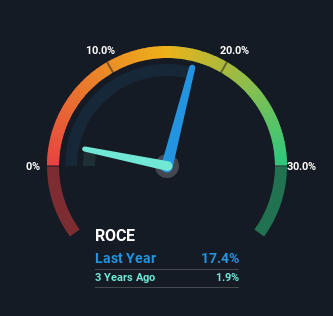
Finding a business that has the potential to grow substantially is not easy, but it is possible if we look at a few key financial metrics. Firstly, we'd want to identify a growing return on capital employed (ROCE) and then alongside that, an ever-increasing base of capital employed. This shows us that it's a compounding machine, able to continually reinvest its earnings back into the business and generate higher returns. With that in mind, we've noticed some promising trends at Byron Energy (ASX:BYE) so let's look a bit deeper.
What Is Return On Capital Employed (ROCE)?
For those who don't know, ROCE is a measure of a company's yearly pre-tax profit (its return), relative to the capital employed in the business. Analysts use this formula to calculate it for Byron Energy:
Return on Capital Employed = Earnings Before Interest and Tax (EBIT) ÷ (Total Assets - Current Liabilities)
0.17 = US$24m ÷ (US$144m - US$6.5m) (Based on the trailing twelve months to June 2023).
Therefore, Byron Energy has an ROCE of 17%. In absolute terms, that's a satisfactory return, but compared to the Oil and Gas industry average of 14% it's much better.
View our latest analysis for Byron Energy

Above you can see how the current ROCE for Byron Energy compares to its prior returns on capital, but there's only so much you can tell from the past. If you'd like to see what analysts are forecasting going forward, you should check out our free report for Byron Energy.
What Does the ROCE Trend For Byron Energy Tell Us?
We like the trends that we're seeing from Byron Energy. The data shows that returns on capital have increased substantially over the last five years to 17%. The amount of capital employed has increased too, by 354%. So we're very much inspired by what we're seeing at Byron Energy thanks to its ability to profitably reinvest capital.
One more thing to note, Byron Energy has decreased current liabilities to 4.5% of total assets over this period, which effectively reduces the amount of funding from suppliers or short-term creditors. This tells us that Byron Energy has grown its returns without a reliance on increasing their current liabilities, which we're very happy with.
Our Take On Byron Energy's ROCE
All in all, it's terrific to see that Byron Energy is reaping the rewards from prior investments and is growing its capital base. Astute investors may have an opportunity here because the stock has declined 68% in the last five years. With that in mind, we believe the promising trends warrant this stock for further investigation.
If you want to continue researching Byron Energy, you might be interested to know about the 1 warning sign that our analysis has discovered.
While Byron Energy may not currently earn the highest returns, we've compiled a list of companies that currently earn more than 25% return on equity. Check out this free list here.
Valuation is complex, but we're here to simplify it.
Discover if Byron Energy might be undervalued or overvalued with our detailed analysis, featuring fair value estimates, potential risks, dividends, insider trades, and its financial condition.
Access Free AnalysisHave feedback on this article? Concerned about the content? Get in touch with us directly. Alternatively, email editorial-team (at) simplywallst.com.
This article by Simply Wall St is general in nature. We provide commentary based on historical data and analyst forecasts only using an unbiased methodology and our articles are not intended to be financial advice. It does not constitute a recommendation to buy or sell any stock, and does not take account of your objectives, or your financial situation. We aim to bring you long-term focused analysis driven by fundamental data. Note that our analysis may not factor in the latest price-sensitive company announcements or qualitative material. Simply Wall St has no position in any stocks mentioned.
About ASX:BYE
Byron Energy
Engages in the exploration, development, and production of oil and gas properties.
Low and fair value.

